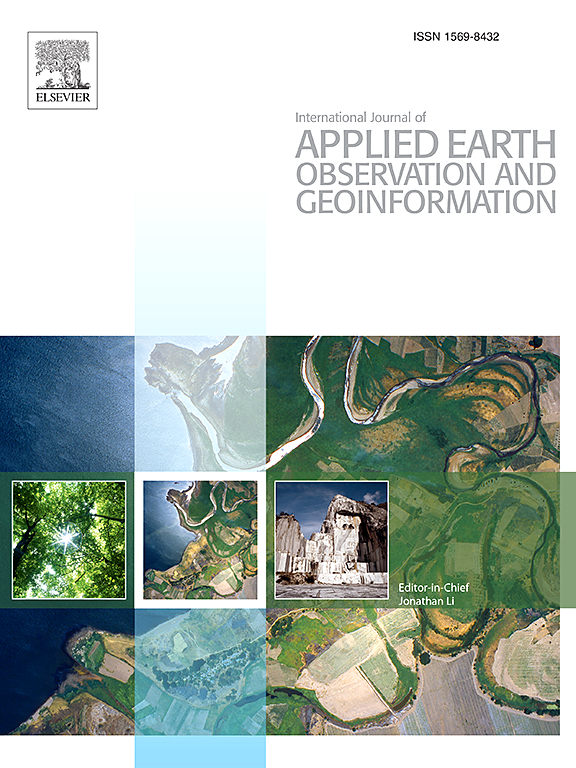High-resolution surface soil moisture retrieval: A hybrid machine learning framework integrating change detection and downscaling for precision water management
IF 8.6
Q1 REMOTE SENSING
International journal of applied earth observation and geoinformation : ITC journal
Pub Date : 2025-06-30
DOI:10.1016/j.jag.2025.104702
引用次数: 0
Abstract
Soil moisture (SM) is vital for comprehending the hydrological cycle and managing climatic extremes. Fine-scale accurate SM products hold more and more significant value to water management and precise agricultural irrigation. While in-situ measurements provide high accuracy, their limited spatial coverage and high costs necessitate alternative approaches. Remote sensing enables large-scale monitoring; however, satellite-based SM products have relatively lower spatial resolution, making them less suitable for practical applications. This study presents an innovative high-resolution surface soil moisture (SSM) retrieval framework combining machine learning (ML), change detection and downscaling (CD-DS) methods. The procedure is applied over Catalonia, Spain. The framework integrates Sentinel-1 SAR, Sentinel-2 normalized difference vegetation indices (NDVI), and DISPATCH background SSM data to generate 30-m resolution SSM. A novel backscatter difference variable, derived from the change detection method, improves model performance by addressing vegetation. The ML model was trained using in-situ SSM data collected from 2017 to 2021 and validated against independent in-situ measurement datasets. Among the evaluated algorithms, XGBoost model performed best, achieving an R2 of 0.933 and RMSE of 0.023 cm3/cm3. Validation with ground measurements with different landcover types showed an average correlation of 0.63, a ubRMSE of 0.045 cm3/cm3, and minimal bias of 0.024 cm3/cm3. Notably, backscatter difference emerged as the second most important variable in the ML model after background SSM, highlighting its significance in improving SSM retrieval accuracy. Comparisons with data from 54 measurement sites, obtained during a 2015 field campaign, yielded an R value of 0.82, a RMSE of 0.06 cm3/cm3. Temporal analysis revealed strong consistency with in-situ data, capturing seasonal trends and abrupt changes after precipitation and irrigation events. Furthermore, the spatial distribution of SSM is closely aligned with irrigation type maps, showing higher SSM values in irrigated areas and lower values in rainfed regions. This approach delivers precise field-scale SSM estimates, making it a valuable tool for drought monitoring and modern agricultural practices.
高分辨率地表土壤水分检索:一种混合机器学习框架,集成了精确水管理的变化检测和降尺度
土壤湿度对理解水文循环和管理极端气候至关重要。小尺度精准SM产品在水资源管理和精准农业灌溉中具有越来越重要的价值。虽然原位测量提供了高精度,但其有限的空间覆盖范围和高成本需要替代方法。遥感使大规模监测成为可能;然而,基于卫星的SM产品空间分辨率相对较低,不太适合实际应用。本研究提出了一种结合机器学习(ML)、变化检测和降尺度(CD-DS)方法的创新型高分辨率表层土壤水分(SSM)检索框架。该程序适用于西班牙加泰罗尼亚。该框架整合了Sentinel-1 SAR、Sentinel-2归一化植被指数(NDVI)和DISPATCH背景SSM数据,生成30m分辨率SSM。从变化检测方法中衍生出一种新的后向散射差分变量,通过对植被进行寻址来提高模型的性能。ML模型使用2017年至2021年收集的原位SSM数据进行训练,并针对独立的原位测量数据集进行验证。在评价的算法中,XGBoost模型表现最好,R2为0.933,RMSE为0.023 cm3/cm3。对不同土地覆盖类型的地面测量结果进行验证,平均相关系数为0.63,ubRMSE为0.045 cm3/cm3,最小偏差为0.024 cm3/cm3。值得注意的是,后向散射差成为ML模型中仅次于背景SSM的第二大重要变量,突出了其对提高SSM检索精度的重要性。与2015年野外活动中获得的54个测点的数据进行比较,R值为0.82,RMSE为0.06 cm3/cm3。时间分析结果显示,降水和灌溉事件后的季节趋势和突变与原位数据具有较强的一致性。此外,SSM的空间分布与灌区类型图密切相关,灌区SSM值较高,灌区SSM值较低。这种方法提供了精确的田间SSM估算,使其成为干旱监测和现代农业实践的宝贵工具。
本文章由计算机程序翻译,如有差异,请以英文原文为准。
求助全文
约1分钟内获得全文
求助全文
来源期刊

International journal of applied earth observation and geoinformation : ITC journal
Global and Planetary Change, Management, Monitoring, Policy and Law, Earth-Surface Processes, Computers in Earth Sciences
CiteScore
12.00
自引率
0.00%
发文量
0
审稿时长
77 days
期刊介绍:
The International Journal of Applied Earth Observation and Geoinformation publishes original papers that utilize earth observation data for natural resource and environmental inventory and management. These data primarily originate from remote sensing platforms, including satellites and aircraft, supplemented by surface and subsurface measurements. Addressing natural resources such as forests, agricultural land, soils, and water, as well as environmental concerns like biodiversity, land degradation, and hazards, the journal explores conceptual and data-driven approaches. It covers geoinformation themes like capturing, databasing, visualization, interpretation, data quality, and spatial uncertainty.
 求助内容:
求助内容: 应助结果提醒方式:
应助结果提醒方式:


